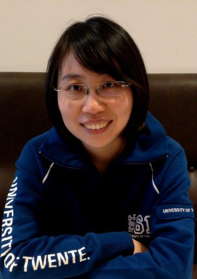Synchotron radiation studies of magnetic materials and devices
Promotion date: 25. May 2012
Promotor: Prof. dr. ir. Wilfried van der Wiel
Co-promotor: Prof. Y. Xu
Assistant promotor: Dr. ir. Michel de Jong
| This PhD thesis aims to tackle and provide insights to both conventional magnetic materials and new-generation spintronic devices, by taking advantages of the element-specificity and tunable photon energy of synchrotron-radiation-based spectroscopy and microscopy techniques, namely, X-ray magnetic circular dichroism (XMCD) and photoemission electron microscopy (PEEM). As a powerful tool to look into magnetism down to nanoscales, XMCD can uniquely reveal and separate the spin- and orbital magnetic moments, the microscopic origin of magnetism of a given magnetic material. Using angle-dependent XMCD, we have addressed a long-time bottleneck of conventional, technologically-important perpendicular magnetic recording in deciding the optimum magnetic grain size of the recording media. We have also utilized an advanced microscope, XMCD-PEEM (one of the few available in the world), that combines the techniques of XMCD and PEEM, to directly image the real-space spin structures of artificially-made magnetic nano-objects. A direct evidence has been offered for the very first time of a new regime of nanosecond dynamics of magnetic domain wall displacements in the nano-objects, triggered purely by an electrical current, unlike the generally conceived belief of an external magnetic field. Our demonstration conveys a perspective of paramount importance for developing new functional domain wall devices, where engineering of the nano-structure geometry and materials are keys to controlling the frequency and oscillation strength of the domain wall motions in these devices. |
Was your project a combination of fundamental and application oriented research?
Yes. It is mainly focused on the area of nano-magnetism and spin-electronics, which is highly relevant to the current data storage technology. The experiments were done in several top synchrotron light sources in the world.
For instance, at the US light source in Berkeley, we have addressed a well-known dilemma in conventional perpendicular magnetic recording, and found out the microscopic origin of this dilemma which hinders the development in realizing the high recording density.
We have also monitored the oscillatory domain wall motion in magnetic nanowires driven by electric current only. This kind of device has been proposed to be new-generation memory devices, where the magnetic domains separated by the domain walls behave as memory bits. Our findings can be of importance for the community to obtain high-density memory capacity with low power consumption.
Can you recall a specific moment during your thesis period that meant a lot to you?
The specific moment would be some hard period when I prepared and performed the 24-hour running experiments (beamtimes) at the light sources. For instance, the samples (in nano-scales) for the US beamtimes required very careful protection (from heat, oxidation, and even breaking, etc.), which meant I had to do a perfect design before carrying them to the US. Moreover, due to the time limitation for each beamtime (less than four days), I had to work overnight to pursue the measurements and had little sleep, which is a challenge physically and requires a perfect plan before the beamtime. I owed great thanks to my collaborators, who helped me a lot during the beamtimes.
Did you have some nice publications?
During my PhD, I had eleven papers published, in Journal of Applied Physics, Applied Physics Letters, Physical Review B, IEEE Transactions on Magnetics, Physica Status Solidi A, and so on.
Also, I have three papers submitted to three top journals, which are under review now. In addition, I had eight presentations at a few international conferences, one of which has won the Best Poster Award.
In what way did you develop as a scientist and researcher during your PhD?
I was very lucky to work in the NanoElectronics group: advanced facilities, cooperative colleagues, etc. And of course our group is young and passionate, and the group leader and my promoters are modest and easy to communicate with. I enjoyed this working environment and atmosphere.
From my side, to do a successful PhD, of course a creative idea, reasonable motivation and good time schedule and management are important. Also I realized the importance of and benefit from communicating with researchers in different disciplines and building my own expertise network, as the trend of modern science is getting more and more interdisciplinary.
One more important thing is - never give up no matter what kind of results you’ve got.
What are your future plans?
I’m looking for a postdoctoral position now, still focused on the area of spintronics and nanotechnology. There are many famous and top research groups at spintronics in Europe. I hope to further build up my network with these top researchers and learn more before going back to China. Hopefully I can also introduce some of the relaxing atmosphere of research into my home country.
What, in your opinion, is important for Mesa+ to stay successful in future?
In my opinion, Mesa+ has been very successful already. One thing, which can be improved, is its world-wide reputation to attract more intelligent students from Asia. E.g. they may held graduation ceremonies once every few years in Asia (China, Japan, India, etc.) for the Asian families to attend them more easily. This could be a good way to bring the institute and even the university close to the students and family members in Asia.

